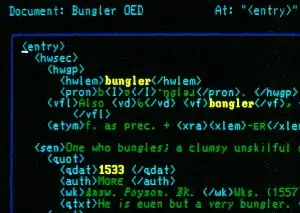LEXX (text editor)
LEXX is a text editor which was possibly the first to use live parsing and colour syntax highlighting. It was written by Mike Cowlishaw of IBM in 1985. The name was chosen because he wrote it as a tool for lexicographers, during an assignment for Oxford University Press's 'New Oxford English Dictionary' (NOED; the second edition of the Oxford English Dictionary).[1] The program ran (and still, in 2018, runs[2]) on mainframes under VM/CMS.[3] LEXX's design was based on several other editors written by the same author (such as STET) augmented by the ability to dynamically parse text and display colour on the new colour terminals that had recently become available (PC-based, and stand-alone such as the IBM 3279). It was programmable using dynamically-loaded compiled commands (usually written in PL/I) or using interpreted commands (usually written in REXX — hence the 'XX' in 'LEXX').

LEXX uses dynamically-loaded parsers which assign classes of elements (tokens formed from character strings) to fonts and colors.[4] It allows indentation to be used to format and show the structure of the file being edited, and other formatting options allow (for example) the hiding of selected classes of text, such as tags. A collection of screenshots is available.[5]
LPEX ('Live Parsing Editor"[6]) is a reimplemented derivative of the LEXX concept, originally produced for OS/2 and AIX.[7] It now also runs on Windows, Linux, and the Java JVM.[8]
References
- Mike Cowlishaw FREng BSc CEng FIET FBCS CITP, IBM, archived from the original on 2006-10-18, retrieved 2008-10-08,
In 1985 he was seconded to the Oxford University Press to write a syntax-directed colour-coding editor for the SGML text of the second edition of the Oxford English Dictionary. That editor (the live parsing editor, called LEXX) and its LPEX derivatives became part of the IBM VisualAge range of products, running on VM/CMS, OS/2, OS/400, AIX, Windows, and Java. Mike remains a consultant to the Oxford English Dictionary.
- http://www.vm.ibm.com/download/packages/ VM Download Packages
- Cowlishaw, M. F. (1987), "LEXX – A programmable structured editor", IBM Journal of Research and Development (PDF), vol. 31
- Foulger, Davis, Agent Software Prototypes and Implementations, archived from the original on 2009-01-07, retrieved 2008-10-08
- | LEXX screenshots
- Clark, Douglas (February 16, 2003), LPEX - The 'Other' Programmer's Editor, OS/2 eZine, retrieved 2008-10-08,
LPEX gets its initials from the name "live parsing editor." It parses the lines you type, as your type them, and displays syntax errors immediately; you don't have to run the source code through the compiler or interpreter to catch simple syntax errors.
- Woehr, Jack (March 1, 1996), A Conversation with Michael Cowlishaw, Dr. Dobb's, retrieved 2008-10-08,
MFC: Around 1985, the Oxford University Press needed an editor that could handle highly structured data: the content of the Oxford English Dictionary, which is about a 20-volume, 1000-page-per-volume dictionary. So I wrote an editor for them called "LEXX" which ran on IBM mainframes. It's now mostly used for program editing, because of its ability to parse data and color keywords, and other features.
- LPEX for Eclipse summary
External links
- Casey, John (July 12, 2006), Creating user profiles for the LPEX editor in WebSphere Developer for zSeries v6.0, IBM, retrieved 2008-10-08
- Casey, John (June 8, 2006), Extending the LPEX Editor in WebSphere Developer for zSeries v6.0, IBM, retrieved 2008-10-08
- G. F. Coulouris; I. Durham; J. R. Hutchinson; H. H. Patel; T. Reeves; D. G. Winderbank (October 27, 2006), "The design and implementation of an interactive document editor", Software: Practice and Experience, vol. 6, Wiley Interscience, archived from the original on January 5, 2013
- Introducing the LPEX Editor, IBM, 1998, archived from the original on 2003-05-14, retrieved 2008-10-08